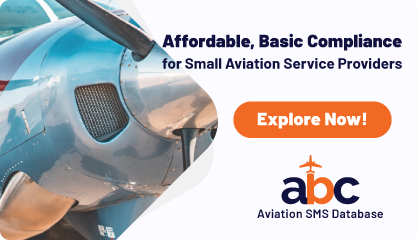
The International Civil Aviation Organization (ICAO) has established a comprehensive Safety Management System (SMS) framework to ensure safety is systematically managed across the global aviation industry. Central to this framework is the Safety Policy pillar, which serves as the foundation for an organization’s commitment to safety.
For aviation safety managers, mastering the Safety Policy pillar is essential for fostering a proactive safety culture, ensuring regulatory compliance, and protecting lives.
This article explores the Safety Policy pillar as outlined in ICAO Annex 19, focusing on its three critical components: the
- Statement of Commitment, also known as CEO Commitment to Safety,
- Safety Objectives, and
- Roles and Responsibilities.
By understanding and implementing these elements, safety managers can build a robust SMS that aligns with international standards and drives continuous improvement.
Related Articles on Continuous Improvement in Aviation SMS Implementations
- What Continuous Improvement Compliance Looks Like in Real SMS Implementation
- 4 Pillars | Truth About SMS Continuous Improvement and KPIs - With Free KPI Resources
- How to Be Compliant With Continuous Improvement of SMS
What is the Safety Policy Pillar in Aviation SMS?
The Safety Policy pillar is one of the four components of ICAO’s SMS framework, alongside Safety Risk Management, Safety Assurance, and Safety Promotion. As detailed in ICAO’s SMS Overview, it establishes an organization’s commitment to safety and defines the methods, processes, and organizational structure needed to achieve safety goals.
The Safety Policy is not just a document—it’s a strategic framework that guides safety management across all levels of an aviation organization.
The Safety Policy and Objectives component, as per ICAO Annex 19, includes:
-
Management commitment and responsibility
-
Safety accountabilities of managers
-
Appointment of key safety personnel
-
SMS implementation plan
-
Coordination of emergency response planning
-
Documentation
This article focuses on three key elements—Statement of Commitment, Safety Objectives, and Roles and Responsibilities—that are critical for aviation safety managers to implement effectively.
1. Statement of Commitment: Leadership’s Pledge to Safety

The Statement of Commitment is a formal, signed declaration from the accountable executive—typically the CEO or a senior leader—affirming the organization’s dedication to safety. This statement is a cornerstone of the Safety Policy, setting the tone for the entire organization and demonstrating that safety is a core value.
Why It Matters
The Statement of Commitment is vital for several reasons:
-
Leadership Buy-In: It shows that safety is prioritized at the highest levels, encouraging employees to follow suit.
-
Cultural Influence: A visible commitment from leadership fosters a safety culture where employees feel empowered to report hazards.
-
Resource Assurance: It pledges the allocation of resources, such as training and technology, to support safety initiatives.
Top management commitment is a key element of the Safety Policy, ensuring that safety is integrated into all organizational activities.
Crafting an Effective Statement of Commitment
To create a compelling Statement of Commitment, safety managers should work with the accountable executive to ensure it is:
-
Clear and Concise: Use straightforward language to communicate the commitment to safety.
-
Specific: Reference compliance with ICAO standards and the provision of resources.
-
Visible: Display the statement in safety manuals, training materials, and on company websites.
Example Statement of Commitment
“At [Organization Name], safety is our highest priority. As the Accountable Executive, I am fully committed to ensuring our operations meet or exceed all applicable regulations, including ICAO Annex 19. We will provide the necessary resources, training, and support to maintain a proactive safety culture. Every employee is encouraged to report hazards without fear of reprisal, contributing to our goal of continuous safety improvement.”
—[Name], Accountable Executive
Actionable Tips for Safety Managers
-
Engage Leadership Early: Collaborate with the accountable executive to align the statement with organizational values.
-
Communicate Regularly: Reinforce the statement through safety briefings, newsletters, and onboarding programs.
-
Review Periodically: Update the statement to reflect changes in leadership or organizational priorities.
By embedding the Statement of Commitment into daily operations, safety managers can ensure that safety remains a shared value across the organization. SMS Pro includes audit tools and automated alerts notifying management that the policy needs to be reviewed. These features ensure safety does not "fall through the cracks."
Free Bonus Resource
2. Safety Objectives: Setting Measurable Goals for Safety
Safety Objectives are specific, measurable goals that guide an organization’s safety efforts. These objectives translate the broad commitment to safety into actionable targets, such as reducing incident rates or increasing hazard reporting. According to FAA’s SMS Components, clear safety objectives are essential for measuring performance and ensuring accountability.
Related Articles on Aviation SMS Goals and Objectives
- What Are Safety Objectives in Aviation SMS - With Examples
- How to Create Safety Objectives in Aviation SMS With Examples
- How to Maintain Monthly Aviation SMS Hazard Reporting Goals
Why Safety Objectives Are Critical
Safety Objectives serve multiple purposes:
-
Focus Efforts: They prioritize resources and initiatives to address key risks.
-
Measure Progress: They provide quantifiable metrics to track safety performance.
-
Demonstrate Compliance: They show regulators that the organization is proactively managing safety.
Characteristics of Effective Safety Objectives
To be effective, Safety Objectives should follow the SMART framework:
-
Specific: Clearly define the goal (e.g., “Reduce runway incursion incidents”).
-
Measurable: Include quantifiable metrics (e.g., “by 20% within 12 months”).
-
Achievable: Set realistic targets based on resources and data.
-
Relevant: Align with organizational priorities and ICAO standards.
-
Time-Bound: Specify a deadline (e.g., “by Q4 2025”).
Example Safety Objectives
-
Reduce runway incursions by 20% within 18 months through enhanced pilot training and air traffic control coordination.
-
Increase hazard reporting by 30% by Q2 2026 by implementing an anonymous reporting system.
-
Achieve 100% completion of SMS training for all operational staff by the end of the fiscal year.
How to Develop Safety Objectives
Safety managers can follow these steps:
-
Analyze Data: Review incident reports, safety audits, and hazard logs to identify trends.
-
Engage Stakeholders: Consult operational teams and regulators to ensure objectives are realistic.
-
Align with Standards: Ensure compliance with ICAO, FAA, or EASA requirements.
-
Monitor Progress: Use safety performance indicators (SPIs) to track and adjust objectives.
Actionable Tips for Safety Managers
-
Leverage Technology: Use SMS software to track progress toward objectives.
-
Communicate Goals: Share objectives with employees to foster buy-in.
-
Celebrate Milestones: Recognize achievements to reinforce a positive safety culture.
By setting and achieving Safety Objectives, safety managers can drive measurable improvements in safety performance, enhancing both compliance and operational efficiency. Tracking objectives with modern database software remains the most prudent method for tracking safety objectives. Otherwise, safety managers lack the time and expertise to effectively manage objectives year after year.
Related Aviation Safety Software Articles
- How to Choose Aviation SMS Software - Educating SMS Professionals
- How to Choose the Best Aviation Safety Database Software
- 20 Benefits of Aviation SMS Software
3. Roles and Responsibilities: Ensuring Accountability
Roles and Responsibilities define the specific duties of all staff, from leadership to frontline employees, ensuring that safety is a shared responsibility. As outlined in ICAO’s SMS Overview, safety accountabilities and the appointment of key safety personnel are critical elements of the Safety Policy.
Why Roles and Responsibilities Matter
Clear definitions of roles:
-
Clarify Expectations: Ensure all employees understand their safety duties.
-
Promote Accountability: Hold individuals accountable for their contributions.
-
Support Compliance: Align with ICAO’s requirement for defined safety responsibilities.
Key Roles in a Safety Policy
The Safety Policy should outline responsibilities for:
-
Accountable Executive:
-
Provides leadership and resources for safety initiatives.
-
Signs the Statement of Commitment and oversees SMS implementation.
-
Ensures alignment with organizational and regulatory goals.
-
-
Safety Manager:
-
Develops and monitors the SMS and Safety Policy.
-
Conducts risk assessments, investigates incidents, and tracks performance.
-
Acts as the primary contact for regulatory authorities.
-
-
Operational Staff (e.g., Pilots, Maintenance Teams):
-
Adhere to safety procedures and report hazards promptly.
-
Participate in safety training and improvement initiatives.
-
-
All Employees:
-
Engage in the safety culture by reporting concerns and following policies.
-
How to Define Roles and Responsibilities
Safety managers can:
-
Map Organizational Structure: Identify all roles within the organization.
-
Assign Specific Duties: Clearly articulate safety tasks for each role.
-
Communicate Expectations: Include roles in SMS documentation and training.
-
Provide Training: Equip employees to fulfill their safety responsibilities.
Example Roles and Responsibilities
-
Accountable Executive: “I will ensure sufficient resources are allocated to safety programs and review safety performance quarterly.”
-
Safety Manager: “I am responsible for maintaining the SMS, conducting monthly audits, and reporting to the accountable executive.”
-
Pilots: “We will report safety concerns, such as equipment issues, within 24 hours via the hazard reporting system.”
Actionable Tips for Safety Managers
-
Use Visual Aids: Create org charts to illustrate safety roles and reporting lines.
-
Encourage Communication: Foster an environment where employees can clarify their responsibilities.
-
Review Regularly: Update roles as the organization or regulations evolve.
By clearly defining Roles and Responsibilities, safety managers can ensure safety is integrated into every level of the organization.
Related Aviation Duties and Responsibilities Articles
- Distinguishing Between Responsibility, Authority, and Accountability in Your Aviation SMS
- How to Assign Duties and Responsibilities in Aviation Safety Management
- FAA Part 5 - Review Management Responsibility in Aviation SMS
Integrating the Components into a Cohesive Safety Policy
To create an effective Safety Policy, aviation safety managers must integrate the Statement of Commitment, Safety Objectives, and Roles and Responsibilities into a unified framework. This involves:
-
Aligning with SMS: Ensure the policy supports all four SMS pillars.
-
Engaging Employees: Involve staff in developing and reviewing the policy to foster ownership.
-
Communicating Consistently: Use multiple channels to reinforce the policy’s messages.
-
Monitoring and Improving: Regularly review the policy for relevance and compliance.
Why an Evergreen Safety Policy Matters
An evergreen Safety Policy remains relevant despite technological or regulatory changes. By focusing on timeless principles—leadership commitment, measurable goals, and clear responsibilities—safety managers can create a policy that endures. This approach ensures compliance and positions the organization as a leader in aviation safety.
Conclusion: Empowering Aviation Safety Managers
The Safety Policy pillar is the backbone of an effective SMS. Through a strong Statement of Commitment, clear Safety Objectives, and well-defined Roles and Responsibilities, aviation safety managers can build a proactive safety culture that meets ICAO standards and drives continuous improvement. By implementing these components, safety managers not only ensure compliance but also contribute to safer skies worldwide.
Take action today: review your Safety Policy, engage leadership, and set SMART objectives. Share this guide with your team to spark discussions on strengthening your safety culture. For more resources, explore ICAO’s Safety Management page or our free resources below.
Last updated May 2025.






